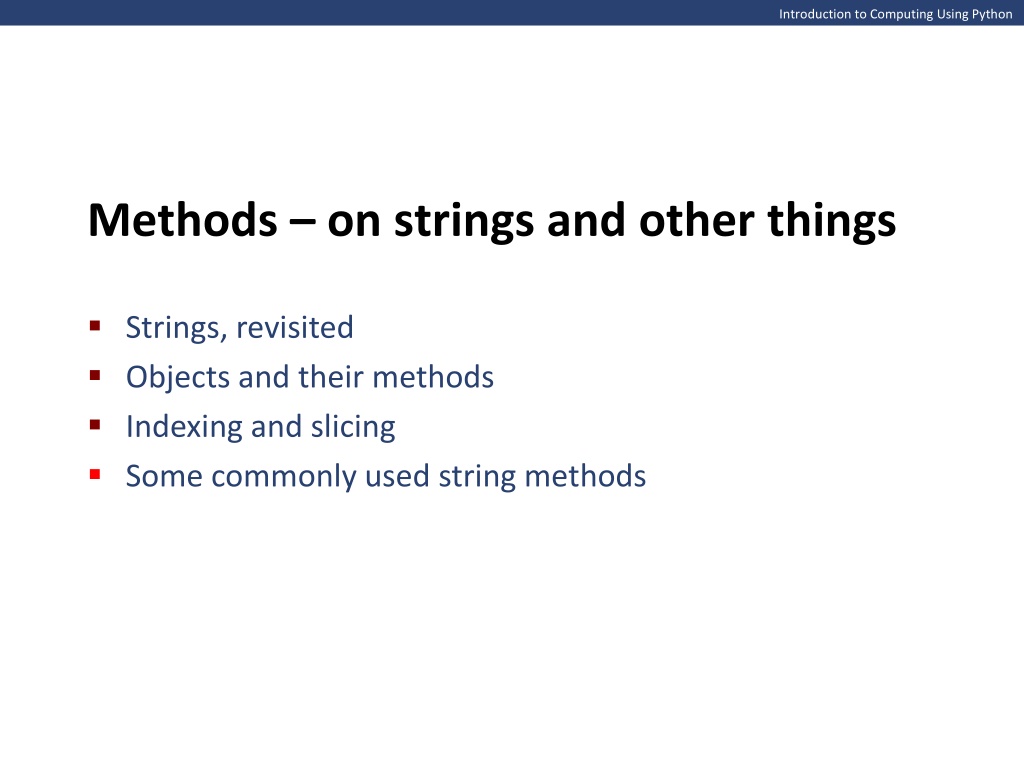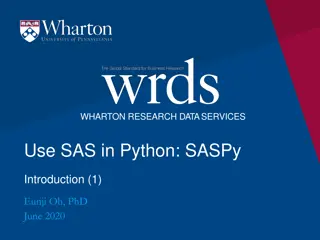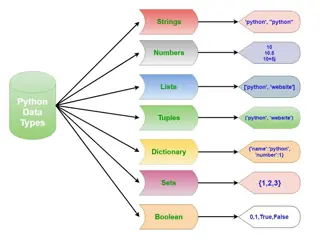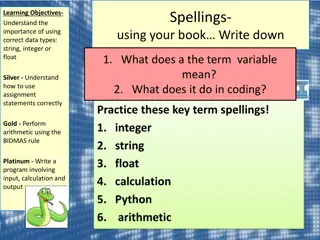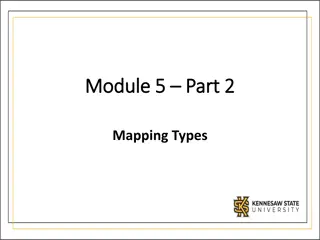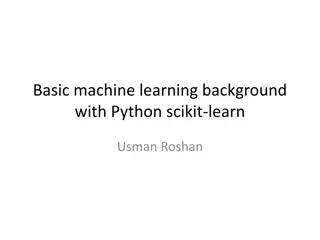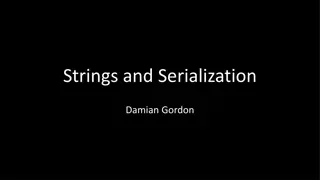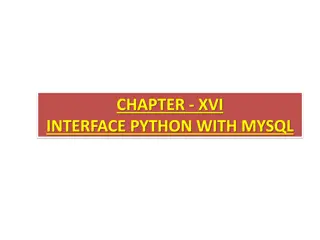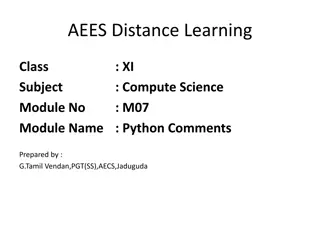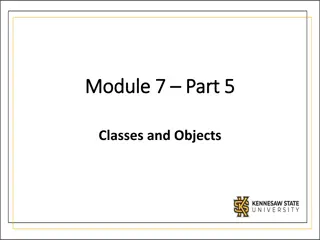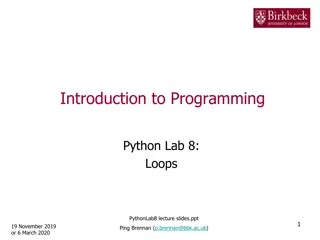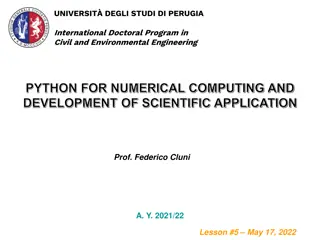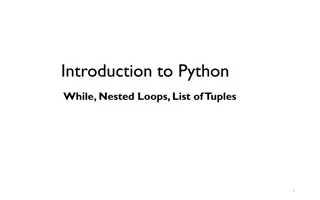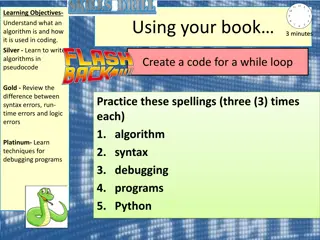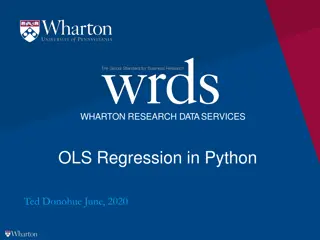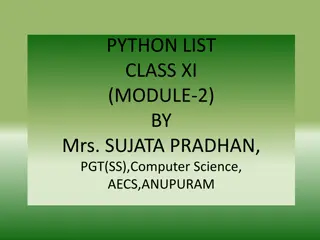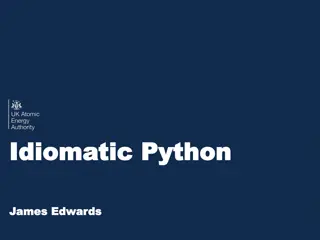Introduction to String Methods in Python
Exploring the manipulation and usage of strings in Python, covering string delimiting, including quote characters in strings, format characters, indexing, slicing, and more. Examples and explanations provided.
Download Presentation

Please find below an Image/Link to download the presentation.
The content on the website is provided AS IS for your information and personal use only. It may not be sold, licensed, or shared on other websites without obtaining consent from the author. Download presentation by click this link. If you encounter any issues during the download, it is possible that the publisher has removed the file from their server.
E N D
Presentation Transcript
Introduction to Computing Using Python Methods on strings and other things Strings, revisited Objects and their methods Indexing and slicing Some commonly used string methods
Introduction to Computing Using Python Remember: What is a string? A string is a sequence of zero or more characters A string is delimited (begins and ends) by single or double quotes poem = 'Ode to a Nightingale' lyric = "Roll on, Columbia, roll on" exclamation = "That makes me !#?" The empty string has zero characters ('' or "")
Introduction to Computing Using Python Quote characters in strings You can include a single quote in a double quoted string or a double quote in a single quoted string will = "All the world's a stage" ben = 'BF: "A penny saved is a penny earned"' To put a single quote in a single quoted string, precede it with the backslash ('\') or 'escape' character. >>> will = 'All the world\'s a stage' >>> print(will) All the world's a stage The same goes for double quotes >>> ben = "BF: \"A penny saved is a penny earned\"" >>> print(ben) BF: "A penny saved is a penny earned"
Introduction to Computing Using Python Putting a format character in a string A format character is interpreted by the print() function to change the layout of text To put a format character in a string, precede it with the backslash ('\') A newline is represented by '\n' >>> juliette = 'Good night, good night\nParting is such sweet sorrow' >>> print(juliette) Good night, good night Parting is such sweet sorrow A tab is represented by '\t' >>> tabs = 'col0\tcol1\tcol2' >>> print(tabs) col0 col1 col2
Introduction to Computing Using Python Index of string characters The first character of a string has index 0 >>> greeting = 'hello, world' >>> greeting[0] 'h' >>> 'hello, world'[0] 'h' You can also count back from the end of a string, beginning with -1 >>> greeting = 'hello, world' >>> greeting[-1] 'd' >>> 'hello, world'[-1] 'd'
Introduction to Computing Using Python Slicing a string You can use indexes to slice (extract a piece of) a string aStr[i:j] is the substring that begins with index i and ends with (but does not include) index j >>> greeting = 'hello, world' >>> greeting[1:3] 'el' >>> greeting[-3:-1] 'rl' omit begin or end to mean 'as far as you can go' >>> print(greeting[:4], greeting[7:]) hell world aStr[i:j:k] is the same, but takes only every k-th character >>> greeting[3:10:2] 'l,wr'
Introduction to Computing Using Python Index/slice a string vs index/slice a list How they're the same and how they're different SAME: You can index a list or string by providing an integer index value, beginning with 0 from the left or -1 from the right [i]. You can slice a list or string by providing begin and end values ([i:j]) or begin, end and step values ([i:j:k]) You can omit begin or end ([:j] or [i:]) to mean 'as far as you can go'
Introduction to Computing Using Python List index vs string index (continued) DIFFERENT: if you reference a single element of a list with the index operator ([i]), its type is the type of that element >>> abc = ['a', 'b', 'c'] >>> abc[0] 'a' >>> type(abc[0]) <class 'str'> If you slice (extract a piece of) a list with begin and end ([i:j]) values, you get a sublist (type list) >>> abc[0:2] ['a', 'b'] >>> type(abc[0:2]) <class 'list'>
Introduction to Computing Using Python String methods A method is a function that is bundled together with a particular type of object A string method is a function that works on a string This is the syntax of a method: anObject.methodName(parameterList) For example, >>> 'avocado'.index('a') 0 returns the index of the first 'a' in 'avocado' You can also use a variable of type string >>> fruit = 'avocado' >>> fruit.index('a') 0
Introduction to Computing Using Python Method parameters Like any function, a method has zero or more parameters Even if the parameter list is empty, the method still works on the 'calling' object: >>> 's'.isupper() False Here is a string method that takes two parameters: >>> aStr = 'my cat is catatonic' >>> aStr.replace('cat', 'dog') 'my dog is dogatonic'
Introduction to Computing Using Python Strings are immutable A string is immutable -- once created it can not be modified When a string method returns a string, it is a different object; the original string is not changed >>> aStr = 'my cat is catatonic' >>> newStr = aStr.replace('cat', 'dog') >>> newStr 'my dog is dogatonic' >>> aStr 'my cat is catatonic' However, you can associate the old string name with the new object >>> aStr = 'my cat is catatonic' >>> aStr = aStr.replace('cat', 'dog') >>> aStr 'my dog is dogatonic'
Introduction to Computing Using Python Python string methods Python has many very useful string methods You should always look for and use an existing string method before coding it again for yourself. Here are some s.capitalize() s.count() s.endswith() / s.startswith() s.find() / s.index() s.format() s.isalpha()/s.isdigit()/s.islower()/s.isspace() s.join() s.lower() / s.upper() s.replace() s.split() s.strip()
Introduction to Computing Using Python Python string method documentation You can find the meaning of each of these string methods in the Python documentation Some operations on strings also work with other sequence types, both mutable and immutable. For example: x in s x not in s s + t s*n / n*s len(s) min(s) max(s)
Introduction to Computing Using Python Strings and the print() function The print() function always prints a string. The input() function always inputs a string. Every object in Python has a string representation. Therefore, every object can be printed. When you print a number, a list or a function it is the string representation of the object that is printed print() takes 0 or more arguments and prints their string representations, separated by spaces >>> print('pi =', 3.14) pi = 3.14 >>> def f(): pass >>> print(f) <function f at 0x02C4BD20>
Introduction to Computing Using Python The print separator and end By default, print() separates multiple outputs with spaces You can change this to any string that you want, for example, a colon and a space (': ') >>> print(1, 2, 3, sep=': ') 1: 2: 3 By default, print() ends its output with a newline ('\n') >>> for i in range(3): print(i) 0 1 2 You can change this, for example, to a hyphen >>>for i in range(3): print(i, end='-') 0-1-2-
Introduction to Computing Using Python The string format method The string format() method allows you detailed control over what is printed and its arrangement (including alignment; width; your choice of date, time and number formats; and many other things). Here is an example of how s.format() can be used to control what is printed: >>> print('{} is {}'.format('Big Bird', 'yellow')) Big Bird is yellow >>> print('{} is {}'.format('Oscar', 'grumpy')) Oscar is grumpy
